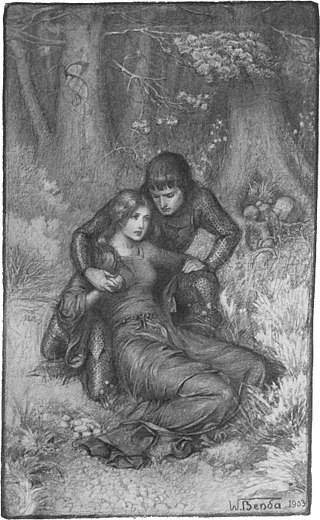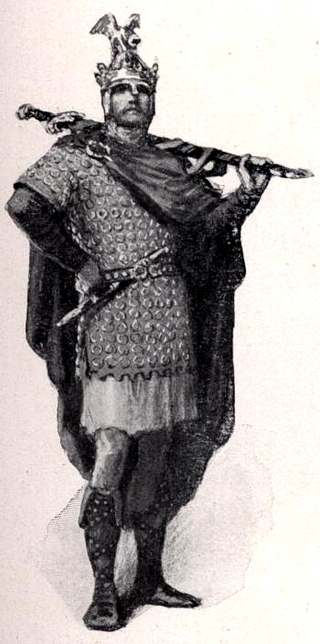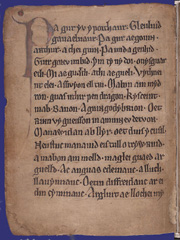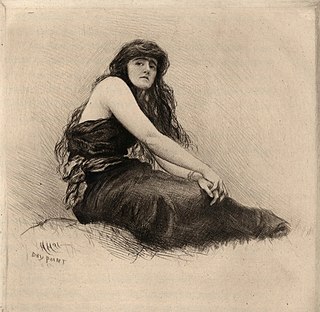Related Research Articles

Excalibur is the mythical sword of King Arthur that may possess magical powers or be associated with the rightful sovereignty of Britain. Traditionally, the sword in the stone that is the proof of Arthur's lineage and the sword given him by a Lady of the Lake are not the same weapon, even as in some versions of the legend both of them share the name of Excalibur. Several similar swords and other weapons also appear within Arthurian texts, as well as in other legends.

King Arthur is a legendary king of Britain, and a central figure in the medieval literary tradition known as the Matter of Britain.
Annwn, Annwfn, or AnnwfynAnnwvn, Annwyn, Annwyfn, Annwvyn, or Annwfyn) is the Otherworld in Welsh mythology. Ruled by Arawn, it was essentially a world of delights and eternal youth where disease was absent and food was ever-abundant. It became identified with the Lutheran afterlife in paradise.

Gwyn ap Nudd is a Welsh mythological figure, the king of the Tylwyth Teg or "fair folk" and ruler of the Welsh Otherworld, Annwn, and whose name means “Gwyn, son of Nudd”. Described later on as a great warrior with a "blackened face", Gwyn is intimately associated with the otherworld in medieval Welsh literature, and is associated with the international tradition of the Wild Hunt.

In the Matter of Britain, Igraine is the mother of King Arthur. Igraine is also known in Latin as Igerna, in Welsh as Eigr, in French as Ygraine, in Le Morte d'Arthur as Ygrayne—often modernised as Igraine or Igreine—and in Parzival as Arnive. She becomes the wife of Uther Pendragon, after the death of her first husband, Gorlois.

Culhwch and Olwen is a Welsh tale that survives in only two manuscripts about a hero connected with Arthur and his warriors: a complete version in the Red Book of Hergest, c. 1400, and a fragmented version in the White Book of Rhydderch, c. 1325. It is the longest of the surviving Welsh prose tales. Lady Charlotte Guest included this tale among those she collected under the title The Mabinogion.
The Thirteen Treasures of the Island of Britain are a series of items in late-medieval Welsh tradition. Lists of the items appear in texts dating to the 15th and 16th centuries. The number of treasures is always given as thirteen, but some later versions list different items, replacing or combining entries to maintain the number.

Welsh mythology consists of both folk traditions developed in Wales, and traditions developed by the Celtic Britons elsewhere before the end of the first millennium. As in most of the predominantly oral societies Celtic mythology and history were recorded orally by specialists such as druids. This oral record has been lost or altered as a result of outside contact and invasion over the years. Much of this altered mythology and history is preserved in medieval Welsh manuscripts, which include the Red Book of Hergest, the White Book of Rhydderch, the Book of Aneirin and the Book of Taliesin. Other works connected to Welsh mythology include the ninth-century Latin historical compilation Historia Brittonum and Geoffrey of Monmouth's twelfth-century Latin chronicle Historia Regum Britanniae, as well as later folklore, such as the materials collected in The Welsh Fairy Book by William Jenkyn Thomas (1908).

Preiddeu Annwfn or Preiddeu Annwn is a cryptic poem of sixty lines in Middle Welsh, found in the Book of Taliesin. The text recounts an expedition with King Arthur to Annwfn or Annwn, the Otherworld in Welsh.
Pridwen was, according to the 12th-century writer Geoffrey of Monmouth, King Arthur's shield; it was adorned with an image of the Virgin Mary. Geoffrey's description of it draws on earlier Welsh traditions found in Preiddeu Annwfn, Culhwch and Olwen, and the Historia Brittonum. The shield is also named and described by Wace, Layamon, Roger of Wendover and Robert of Gloucester among other medieval writers, and it directly inspired the description of Sir Gawain's shield in Sir Gawain and the Green Knight.
Sanddef Pryd Angel is a figure of Welsh tradition. He usually figures as a warrior of King Arthur's court, and is distinguished by his great beauty, which gives him his epithet Pryd or Bryd Angel.
Caer Sidi is the name of a legendary otherworld fortress mentioned in Middle Welsh mythological poems in the Book of Taliesin.

King Arthur's family grew throughout the centuries with King Arthur's legend. Many of the legendary members of this mythical king's family became leading characters of mythical tales in their own right.
Glewlwyd Gafaelfawr is a hero, warrior, and porter in tradition and Arthurian mythology, in which he appears as a knight in Arthur's retinue and chief gatekeeper of his court. He is one of the earliest characters to be associated with Arthur and appears in a number of texts, including Culhwch ac Olwen, Geraint fab Erbin, Iarlles y Ffynnon, Pa Gur yv y Porthur and the Welsh Triads.
Amlawdd Wledig was a legendary king of sub-Roman Britain. The Welsh title [G]wledig, archaically Gwledic or Guletic and Latinised Guleticus, is defined as follows: "lord, king, prince, ruler; term applied to a number of early British rulers and princes who were prominent in the defence of Britain about the time of the Roman withdrawal; (possibly) commander of the native militia ".

Poem 31 of the Black Book of Carmarthen, a mid-13th century manuscript, is known from its first line as Pa gur yv y porthaur? or Pa gur, or alternatively as Ymddiddan Arthur a Glewlwyd Gafaelfawr. It is a fragmentary, anonymous poem in Old Welsh, taking the form of a dialogue between King Arthur and the gatekeeper Glewlwyd Gafaelfawr, in which Arthur boasts of his own exploits and those of his companions, especially Cai the Fair. Pa gur is notable for being one of the earliest vernacular Arthurian works, and for alluding to several early adventures of Arthur which are now lost. Its precise age is not known and has been the subject of wide-ranging disagreement, but scholarly opinion now tends to favour a date of c. 1100.
The nine sorceresses or nine sisters are a recurring element in Arthurian legend in variants of the popular nine maidens theme from world mythologies. Their most important appearances are in Geoffrey of Monmouth's introduction of Avalon and the character that would later become Morgan le Fay, and as the central motif of Peredur's story in the Peredur son of Efrawg part of the Mabinogion.

Gwenddydd, also known as Gwendydd and Ganieda, is a character from Welsh legend. She first appears in the early Welsh poems like the Dialogue of Myrddin and Gwenddydd and in the 12th-century Latin Vita Merlini by Geoffrey of Monmouth, where she is represented as being a figure in the Old North of Britain, the sister of Myrddin or Merlin, and a prophet in her own right. Geoffrey also makes her the wife of the northern king Rhydderch Hael. She was remembered in Welsh traditions recorded in the 16th century by Elis Gruffydd, and even as late as the 18th century. Since the late 19th century she has occasionally appeared as Merlin's sister or lover in Arthurian fiction, poetry and drama by writers such as Laurence Binyon, John Cowper Powys, John Arden, Margaretta D'Arcy and Stephen R. Lawhead.

Heather Dale is a Canadian Celtic folk musician, author, entrepreneur, and filker who was inducted into the Canadian Science Fiction and Fantasy Association's Hall of Fame in 2020. Much of her music draws on Celtic and Arthurian legend, but she also incorporates influences and instruments from other genres, including world music. She runs her own independent record label, Amphis Music, from its office in Toronto, Ontario.
Indeg, daughter of Garwy Hir, was known in early Welsh legend as one of the three mistresses of King Arthur. Though her story seems to have survived down to the later Middle Ages, when she was frequently cited by Welsh poets as a standard for beauty, it has since been lost.
References
- ↑ Coe, Jon B.; Young, Simon (1995). The Celtic Sources for the Arthurian Legend. [Felinfach]: Llanerch. p. 135. ISBN 1897853831 . Retrieved 7 November 2020.
- ↑ Bollard, John K. (1994) [1983]. "Arthur in the Early Welsh Tradition". In Wilhelm, James J. (ed.). The Romance of Arthur. New York: Garland. pp. 19–20. ISBN 0815315112 . Retrieved 7 November 2020.
- ↑ Haycock, Marged, ed. (2007). Legendary Poems from the Book of Taliesin. Aberystwyth: CMCS. p. 441. ISBN 9780952747895 . Retrieved 7 November 2020.
- ↑ Bartrum 2009, p. 624.
- ↑ Davis, Craig (2014). "Arthur in Early Wales/Culhwch and Olwen". In Kibler, William W.; Palmer, R. Barton (eds.). Medieval Arthurian Epic and Romance: Eight New Translations. Jefferson, NC: McFarland. pp. 72, 92–93, 95–96. ISBN 9780786447794 . Retrieved 7 November 2020.
- ↑ Parry, John J.; Caldwell, Robert A. (1979) [1959]. "Geoffrey of Monmouth". In Loomis, Roger Sherman (ed.). Arthurian Literature in the Middle Ages: A Collaborative History. Oxford: Clarendon Press. pp. 73, 80–81, 84. ISBN 9780198115885 . Retrieved 7 November 2020.
- ↑ Lacy, Norris J.; Ashe, Geoffrey; Mancoff, Debra N. (1997). The Arthurian Handbook (2nd ed.). New York: Garland. p. 345. ISBN 9780815320814 . Retrieved 7 November 2020.
- ↑ Wace; Layamon (1921). Arthurian Chronicles. Translated by Mason, Eugene. London: J. M. Dent. p. 17. Retrieved 7 November 2020.
- ↑ Green, Thomas (2009). Arthuriana: Early Arthurian Tradition and the Origins of the Legend. Louth: Lindes Press. p. 98. ISBN 9781445221106 . Retrieved 7 November 2020.
- ↑ Bartrum 2009, p. 362.
- ↑ Some Specimens of the Poetry of the Antient Welsh Bards. Translated by Evans, Evan. London: R. and J. Dodsley. 1764. p. 15. Retrieved 7 November 2020.
- ↑ Lloyd-Morgan, Ceridwen (2004). "Narratives and non-narratives: Aspects of Welsh Arthurian tradition". Arthurian Literature. 21: 128–129. ISBN 9781843840282 . Retrieved 7 November 2020.
- ↑ Howey & Reimer 2006, p. 258.
- ↑ Lupack 2007, p. 467.
- ↑ Howey & Reimer 2006, p. 295.
- ↑ Thompson, Raymond H. (1985). The Return from Avalon: A Study of the Arthurian Legend in Modern Fiction. Westport, Conn.: Greenwood Press. p. 110. ISBN 0313232911 . Retrieved 7 November 2020.
- ↑ Lupack 2007, pp. 199, 467.
- ↑ Lacy, Norris J.; Thompson, Raymond H. (2001). "Arthurian Literature, Art, and Film, 1995–1999". Arthurian Literature. 18: 226. ISBN 9780859916172 . Retrieved 7 November 2020.
- ↑ Howey & Reimer 2006, p. 546.
- ↑ Walker, Aaron, ed. (2015). The Art of Fallout 4. Milwaukie, Oregon: Dark Horse. p. 256. ISBN 9781630086527 . Retrieved 7 November 2020.
- ↑ Poage, Sean (2018). The Retreat to Avalon. USA: Perseid Press. ISBN 8494729896.